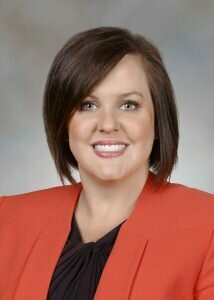Lots of changes happened for every industry during the pandemic, but none saw such significant policy and practice shifts as those experienced by the healthcare sector. Hospitals were on the front line fighting a deadly disease amidst massive challenges like labor shortages, employee safety concerns, major supply chain disruptions, and intense fatigue.
Today, really just a short time away from the worst periods of the crisis, it’s become clear that certain aspects of the healthcare business have been permanently altered. We wanted to know more about the types of things that will never be the same, so we reached out to hospital officials with a straightforward question:
What are some of the lasting changes that hospitals have experienced since the pandemic?
Leaders from several Hoosier hospitals were kind enough to lend us their thoughts about the ways in which the business of healthcare has been forever transformed.
Michelle Janney, Executive Vice President, Chief Operating Officer
 At Indiana University Health, the COVID-19 pandemic led to fundamental changes in our decision-making, care models and planning.
At Indiana University Health, the COVID-19 pandemic led to fundamental changes in our decision-making, care models and planning.
As the pandemic filled hospitals with severely ill patients and tested the limits of caregivers, our leaders realized the crisis required new approaches to how we worked. Decision-making had to happen faster to respond to rapidly changing circumstances. More transparency was called for to reinforce trust among team members, patients, and the public.
Put in place during the pandemic were wide-ranging, positive changes that reflect the organization’s values of purpose, team, compassion, and excellence:
Crises can be a learning experience. The pandemic has spurred us to improve the way we work and how we care for patients, using our values as a guide.
David Crabb, M.D., Chief Medical Officer
 Numerous changes were implemented as a result of the pandemic and are likely permanent. The most highly visible change has been the large increase in the use of remote services (telehealth, electronic consultations, communication with patients by way of portals to the electronic health record). The permanence and form of telehealth services will depend on policies of insurers (requirements for the encounter, payment) and access of patients to reliable internet service. Increased use of electronic communications creates demand for “non-visit care” which falls to many medical specialties.
Numerous changes were implemented as a result of the pandemic and are likely permanent. The most highly visible change has been the large increase in the use of remote services (telehealth, electronic consultations, communication with patients by way of portals to the electronic health record). The permanence and form of telehealth services will depend on policies of insurers (requirements for the encounter, payment) and access of patients to reliable internet service. Increased use of electronic communications creates demand for “non-visit care” which falls to many medical specialties.
High inpatient and outpatient volumes have challenged capacities for all kinds of services. Our ability to respond to the surges of seriously ill COVID patients validated our design of single rooms adaptable to the acuity of the patient (each room can be converted to an ICU room) and we have adapted other units in the hospital to accommodate surges.
The city hospitals responded to the pandemic with increased attention to throughput of patients to eliminate hospital diversion for the emergency medical system (i.e., hospitals being unable to accept patients from ambulance services because of lack of staffed beds). Throughput efforts target improvement in admission from the emergency department, managing the length of stay, and finding alternatives for patients at discharge.
Other operational changes include better ways to track supplies (drugs, devices, personal protective equipment) demanded by the supply chain challenges. Impacting every aspect of care nationally are workforce issues (staffing needs for all category of care providers- nurses, pharmacy, therapists, physicians) and the expansion of virtual work options.
Dr. Erica Kaufman West, MD, Infectious Disease Physician
 Franciscan Health has experienced a lot of change over the course of our 145-year history as we worked to meet the changing needs of the patients we are blessed to serve. One aspect of our healthcare ministry that has not changed is our fidelity to our mission: continuing Christ's ministry in our Franciscan tradition.
Franciscan Health has experienced a lot of change over the course of our 145-year history as we worked to meet the changing needs of the patients we are blessed to serve. One aspect of our healthcare ministry that has not changed is our fidelity to our mission: continuing Christ's ministry in our Franciscan tradition.
While the pandemic brought challenges, it also presented opportunities, including appreciation of the value of healthcare workers in our communities.
While minimizing exposure to infection has always been a priority in hospitals, the pandemic made everyone acutely aware of the role we all play – staff, patients, and visitors – in minimizing risk. From washing and sanitizing hands to wearing appropriate protective equipment to proper cleaning methods, maintaining air flow filters and more, each and every person plays a role in keeping each other safe from harm.
In 2022, Franciscan Health Dyer and Franciscan Health Munster each received the prestigious Infectious Diseases Society of America Antimicrobial Stewardship Center of Excellence designations, making them the only two hospitals in Northwest Indiana with the distinction. They are among just six in the state and 150 in the world to receive the honor. That could not have been achieved without the hard work and dedication of our coworkers during the pandemic and beyond.
My hope is that we all continue to show appreciation for the value of all healthcare workers and role they play in keeping our communities and co-workers safe each and every day.
Alan Kumar, MD, Senior Vice President of Medical Affairs, Chief Medical Officer
 The COVID pandemic was a perfect example of the adaptability needed when situations change – sometimes exceptionally quickly. Health providers forged ahead with building and refining their virtual strategy, thereby helping to ensure telehealth will continue to play a pivotal role in the nation’s healthcare system.
The COVID pandemic was a perfect example of the adaptability needed when situations change – sometimes exceptionally quickly. Health providers forged ahead with building and refining their virtual strategy, thereby helping to ensure telehealth will continue to play a pivotal role in the nation’s healthcare system.
The classic model of requiring patients to come to the doctor’s office or to the hospital for routine care has changed. Healthcare today is increasingly driven by growth in outpatient services with a renewed focus on service and convenience.
Advanced technology allows providers to be more adaptive to meeting patients where they are instead of in a more traditional healthcare setting. In terms of bringing in new patients, telehealth reaches a market of younger patients whose expectations of health care delivery mirrors what they have become used to – a society of instant results and access based on the internet and other on-the-spot consumer websites.
Enhanced feedback between our clinicians and patients strengthens our position in providing optimal healthcare access through a multi-channel approach. Whether we reach patients through phone, video, apps or other modes of telecommunication, our goal is to enhance patients’ connection to healthcare. Within the hospitals, this technology is used for areas such as telestroke and telemonitoring, and in outpatient and office settings through apps and digital connectivity with MyChart.
No matter how the interaction takes place, it is vital to offer patients and their families the ability to connect with their provider. Nothing is more important.
Matt Doyle, President, CEO
 During the pandemic, hospital resources were stretched farther than ever as intuitions across the nation were confronted by skyrocketing drug, labor and equipment costs, as well as lingering supply shortages. But the most severe and lasting problem we have faced is ongoing staffing shortages. For example, while the chronic nursing shortage has persisted for decades, the pandemic caused that problem to become more acute and expand across all clinical areas. We also saw early retirements and career changes driven by burn-out and resignations by those seeking the higher wages available in freelance opportunities.
During the pandemic, hospital resources were stretched farther than ever as intuitions across the nation were confronted by skyrocketing drug, labor and equipment costs, as well as lingering supply shortages. But the most severe and lasting problem we have faced is ongoing staffing shortages. For example, while the chronic nursing shortage has persisted for decades, the pandemic caused that problem to become more acute and expand across all clinical areas. We also saw early retirements and career changes driven by burn-out and resignations by those seeking the higher wages available in freelance opportunities.
As a result, we have had to work hard to maintain and nurture a culture in which high-performing staff who committed to our mission can thrive. At Methodist Hospitals, we are seeking to place employee engagement at the top of our priorities and are committed to ensuring that our staff members have the tools and resources they need to succeed in their roles.
We are taking creative approaches to recruit qualified staff, with tuition reimbursement and loan forgiveness programs along with professional development opportunities and positions offering flexible hours. We have also been gratified by our success in attracting former employees to rejoin the Methodist family. As we celebrate our 100th anniversary in 2023 and embark on our second hundred years of serving Northwest Indiana, we continue to encourage those who share our passion to improve the wellbeing of our neighbors to join the Methodist family.
Ashley Dickinson, CEO
 Throughout even the darkest moments of history, humanity has managed to emerge stronger and more resilient than before. Throughout the COVID-19 pandemic, hospitals were at the forefront of a learning process - adapting our strategies and rethinking our operations and infrastructures to better care for patients.
Throughout even the darkest moments of history, humanity has managed to emerge stronger and more resilient than before. Throughout the COVID-19 pandemic, hospitals were at the forefront of a learning process - adapting our strategies and rethinking our operations and infrastructures to better care for patients.
The pandemic was also a catalyst for transformative changes in the design of new healthcare facilities, creating blueprints that provide a more agile environment in response to change.
The newest designs of hospitals and medical centers are allowing spaces to transform into zero pressure rooms or acuity-adaptable patient care departments. Identifying potential uses of spaces ahead of a crisis allows health care facilities to better adapt to challenges they may face.
Collaboration among teams of engineers, architects and healthcare professionals has created innovative ways to change the care delivery environment to meet patient and community needs.
During the pandemic, hospitals converted inpatient floors into COVID-19 units, updating patient rooms and electrical, air exchange and accessibility. Most hospitals retrofitted areas to separate care for non-COVID-19 patients to the appropriate high standard of care while protecting them from the virus.
Moving forward, healthcare facilities will continue designing with flexibility in mind and even more innovations will evolve. The COVID-19 pandemic was a seismic event that shook the foundations of healthcare, demonstrating the profound impact that an unexpected crisis can have on even the most prepared health care systems. We have learned much from this experience and will continue to prioritize adaptable and resilient infrastructure to care for patients in any circumstance.
Rick Henvey, CEO
 Although virtual care was not new to Parkview Health, the pandemic accelerated the availability and adoption of virtual care options. We saw a rapid increase in the number of virtual visits across all age groups, and volumes have remained strong. Today, 8,000-10,000 patients per month choose to engage with their provider virtually, resulting in approximately 100,000 virtual visits each year.
Although virtual care was not new to Parkview Health, the pandemic accelerated the availability and adoption of virtual care options. We saw a rapid increase in the number of virtual visits across all age groups, and volumes have remained strong. Today, 8,000-10,000 patients per month choose to engage with their provider virtually, resulting in approximately 100,000 virtual visits each year.
Understanding the impact and increased demand of virtual care, in 2022 we expanded the Parkview Digital Care Center to combine care delivery, technology and support in one centralized location for our entire health system. The teams in this location manage virtual visits and interactions through Parkview MyChart and Parkview OnDemand, as well as other technology and patient devices. They also provide 24/7 remote clinical support for all of Parkview’s hospitals. A group of experienced nurses and technicians monitor hospital inpatients across the system and play a key role in patient safety, nurse retention and efficient workflow.
Finally, we’ll launch a new website this spring. We know our website is often someone’s first connection with Parkview. So, we’re working to enhance functionality and user experience, making it easier for individuals to quickly find the information they need, connect to MyChart or start a virtual visit.
We know the continued expansion of digital health tools is essential for engaging our patients and offering flexibility in care options. Parkview will continue to leverage and drive more digital capabilities that enhance the patient experience, personalize communications, and maximize technology to better care for patients when, where and how they prefer.